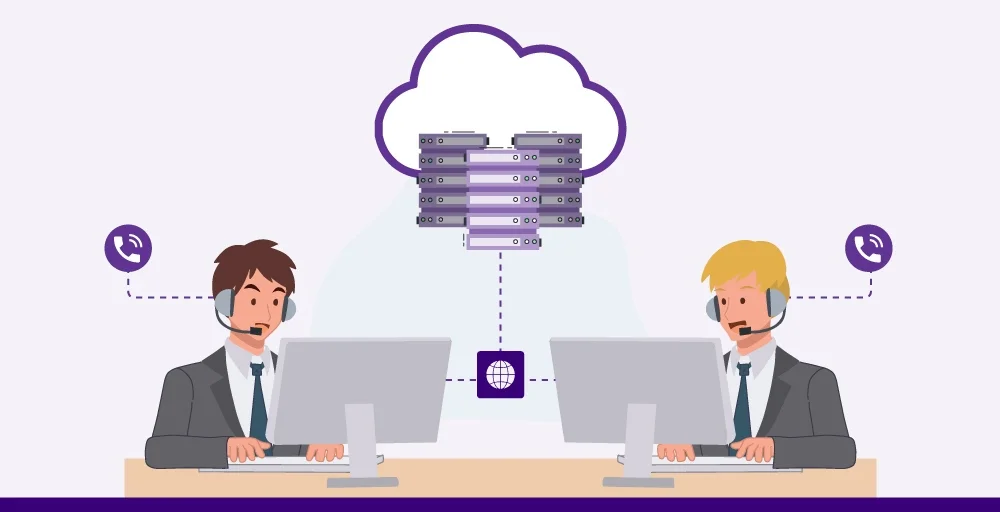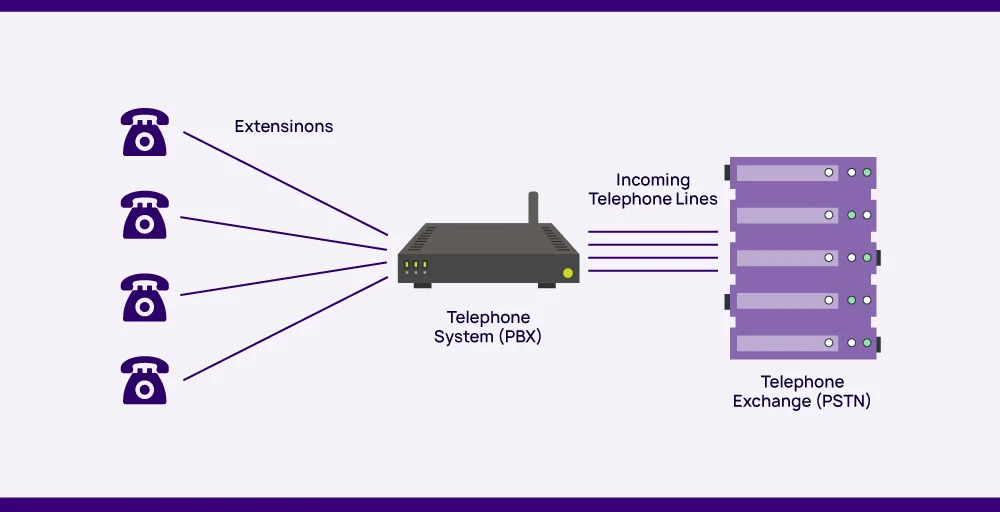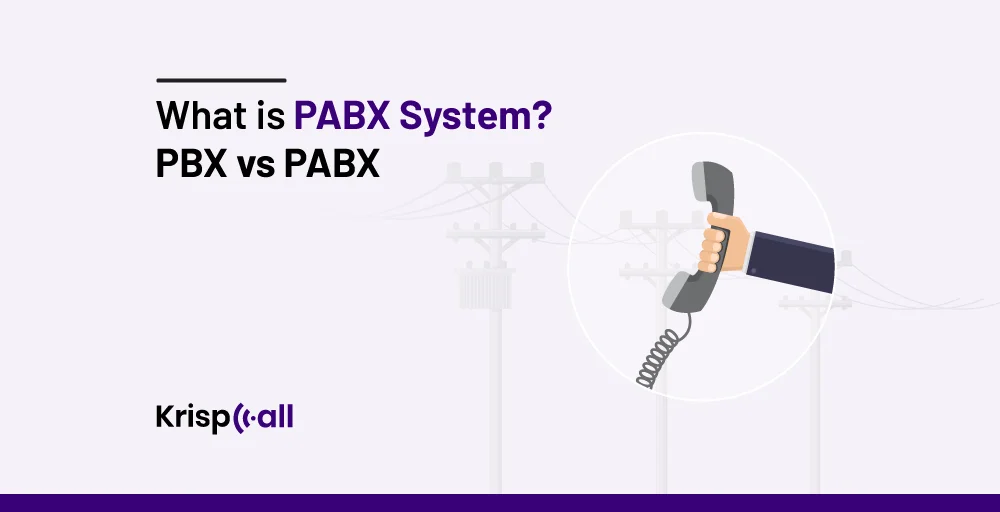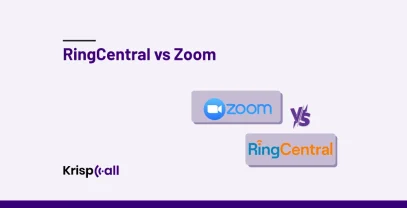Is your company based in multiple locations? 🌐 Or does your company receive a high call volume or have extensive communication needs?
If the answer is yes to any of the questions, your company can use the PABX system.
A PABX system is a complex telephone system used within the organization to manage internal and external communications. It allows multiple users to share a single phone line to communicate across various departments and locations.
In this article, we’ll discuss the PABX system, its benefits, and the factors to consider when choosing the suitable system for your business needs.
Without further ado, let’s begin.
🔑KEY POINTS
- PABX allows internal communication with members through extensions and manages the connection outside the organization via the external phone line.
- PABX supports remote access and mobility features, allowing employees to make and receive calls from anywhere using the internet.
- PABX offers advanced features, such as auto attendant, call monitoring and reporting, voicemail, conferencing, etc., compared to its predecessor PBX system.
What is PABX system?

PABX stands for Private Automatic Branch Exchange System. It is an upgraded version of traditional PBX phone systems that works as a central communication hub within an organization and manages incoming and outgoing external calls. It provides features like call routing, voicemail, and conferencing.
PABX system is used in an organization that requires extensive customer support as well as medium to large with several departments. It manages services like call routing, call processing, and various other telephone functions.
History and Evolution of PABX
Before private exchange, every call used to go through the public exchange. This process needed a one-to-one dedicated phone line. For instance, if your business had four departments, you needed four different phone lines to make and receive calls.
The Private Branch Exchange (PBX) was introduced in the early 1960s to solve that problem. Traditional PBX systems made internal communication easier, as phone calls did not have to go through public exchanges. At this time, the concept of phone extension was introduced, and different departments could be contacted by the same phone if they knew about the extension.
However, the process was manual. The operators had to process the call manually. To combat that issue, the PABX system was introduced in the 1980s, which could switch automatically without human intervention.
From that point forward, the PABX system has been evolving over the decades.
Since the introduction of the Internet for public use around 1993, the process has become much easier and more efficient. VoIP (Voice over Internet Protocol) came into play soon after that and broadened the area of the PABX system. It allows people to make and receive calls and messages through the Internet.
The latest evolution is cloud-based telephony service. This advancement allows companies to build infrastructure over the cloud, eliminating the physical infrastructure in the organization.
Types of PABX Systems
Private automatic branch exchange (PABX) can be classified into three types, as listed below.
- Analog PABX Systems: The Analog system transmits voice signals using analog signaling methods. It is compatible with traditional analog telephones and infrastructure.
- Digital PABX Systems: This system converts voice signals into digital packets before sending them. It is compatible with digital telephones and infrastructure, as well as analog devices with adapters.
- IP PABX Systems: IP BAX system uses Internet Protocol (IP) technology to transmit voice as digital packets through the internet connection or a local area network (LAN). This system is compatible with IP telephones, softphones, and devices, as well as traditional analog and digital devices with adapters.
PABX Vs PBX Systems: What are the Differences?
Both PABX and PBX can be called private telephone networks as they work primarily inside the organization.
The main difference between these two systems is their switching mechanism; PABX offers automatic switching, whereas PBX requires a human to manually operate the switchboard.
Below are the differences between private automatic branch exchange (PABX) and private branch exchange (PBX) systems.
| Factors | PABX | PBX |
| Flexibility | Highly flexible | Limited |
| Cost | Varies depending on on-premise or cloud | Higher cost |
| Features | Offer advanced features | Only limited features |
| Operation | Automatically, without the need for an operator | Manually by operators |
| Technology | Digital or analog | Analog |
| Switching System | Automatic digital switching | Manual analog switching |
| Best For | Advanced use and integration | Basic or simple needs |
How Does a PABX System Work?

The PABX phone system works by managing communication within the organization and efficiently facilitating external calls. Its operation can be explained by dividing its work into different aspects.
- Call Routing: The PABX system receives the calls and determines where to route them based on extension numbers or other predefined criteria. According to the configuration, PABX can direct calls to appropriate departments or external numbers.
- Call Processing: In this step, the PABX phone system establishes the connection between caller and receiver, whether the call is internal or external in nature. Call processing includes functions like call setup, call duration tracking, and call termination.
- Extension Management: The PABX system manages the extension number within the organization. It provides each extension line with a unique number. These extensions can be configured with several features, such as call forwarding, voicemail, and conference calling.
- Trunk Line Management: The trunk line connects the system to the external telephone network, such as the Public Switched Telephone Network (PSTN) and integrated services digital network (ISDN). Depending on the system’s technology, trunk lines can be analog, digital, or VoIP-based. The PABX phone system manages both outgoing and incoming calls to and from external numbers.
- Switchboard Interface: It allows access to features such as call transfer, call monitoring, and call logging through the switchboard interface. Once configured, the process is automatic, but operators and administrators can intervene manually to ensure smooth communication.
- Integration With VoIP Technology: Most modern PABX phone systems use VoIP technology. This technology enables the PABX system to support remote extensions over the internet. This integration makes the PABX system more flexible and cost-effective as the transmission channel is the internet.
Top Features of PABX Systems
The popularity and effectiveness of the PABX system are due to its features. The top features are explained below.
- Call Forwarding: The PABX system can divert incoming calls to external phone lines based on forwarding rules. Rules are made to carry out the operation. For example, a rule to forward calls can be: if the calls are unanswered or unreachable.
- Call Barging: This feature lets you monitor and intervene in live conversations. You can monitor the agent’s performance and de-escalate the situation with the customer if that occurs.
- Auto Attendant: The auto attendant feature is like a virtual assistant that greets callers and routes calls to the concerned departments using a menu option.
- Call Transfer: This feature enables you to transfer calls during the live conversation. It is helpful when another agent is more capable of handling calls in that manner.
- Call Recording: The call recording feature lets you record conversations between your employee and customer. It can be used to improve customer service.
- IVR (Interactive Voice Response): The IVR feature allows the caller to perform several interactive functions with the help of menus without human intervention.
- Do Not Disturb (DND): The Do Not Disturb feature temporarily disables notifications for calls and messages so that you can focus uninterrupted on your task.
- Voicemail: Voicemail allows your callers to leave recorded messages. This feature is helpful when you are unable to answer so that you can follow up on the call.
Benefits of using the PABX system
PABX systems provide advanced features and have evolved from the traditional PBX phone systems. PABX is highly beneficial for businesses that are growing, are located in multiple regions, and have high call volume. Some of the main benefits are:
Easily Scalable
The PABX system is highly scalable. You can expand your organization’s communication infrastructure by adding more extension lines. You don’t need multiple phone lines.
It allows you to integrate new technologies to provide even more advanced features. The inclusion of VoIP is a great example of this.
Cost Savings with Automation
As this system can automate routine tasks and processes, it reduces human intervention, saving time and labor costs. Features such as auto attendant, call routing, and voicemail also help reduce human intervention and help in automation, further making PABX cost-effective.
Provides Advanced Features
This automatic system has advanced features and functionalities, including call recording, call analytics, conference calls, call routing, etc. These features enhance the capability and productivity of the business and help it grow.
Enhanced Professionalism
With features like auto attendant, greeting, and voicemail, businesses can handle calls professionally. Professional communication capabilities help build trust and credibility, enhancing the perception of the organization.
Reduced Dependency on Operators
By reducing manual intervention, the PABX phone system lowers the dependency on human operators for call handling and call routing. Other features, like auto attendant, also help reduce dependency without hampering overall operational efficiency.
Integration Abilities
With the boom in the IT field, there are many products that are capable of taking things to the next level in their domain such as messaging, email management, Customer Relationship Management (CRM), etc. PABX system has the ability to integrate with such products to give better work efficiency.
Are there any Drawbacks to the PABX Phone System?
As there are benefits, there are drawbacks to the PABX system, too. Some of them are listed below.
- PABX system requires regular maintenance for optimal performance. As a result, dedicated IT resources need to be allocated.
- Integrating with existing infrastructure or third-party applications may cause compatibility issues.
- Although modern PABX systems support remote access features, they may not provide the same level of functionality as cloud-based telephony systems.
- As PABX is a complex system, it raises security concerns with threats such as hacking, malware, and unauthorized access, which require robust security measures.
How To Choose the Right PABX (Private Automatic Branch Exchange) System for your business?
Here are the things you should consider before choosing the PABX system for your business.
Scalable
The scalability factor plays a vital role if you are thinking of growing your business. PABX system allows you to add remote extensions, while others do not. Ensure the system can accommodate additional users and extensions without incurring significant costs.
Reliable and Secure
Ensure that the system is from reputed vendors and is reliable and secure. If data leaks and vulnerabilities have happened in the past, check for them. Using a PABX system from such vendors enhances your trust and credibility with your customers.
Compatibility and Integration
Check if the system is compatible with your business’s existing infrastructure, such as network equipment, telephony devices, and business applications. See if your current business tools, such as Salesforce, HubSpot, Zoho, Zapier, etc., can be integrated into that system. This will save you both time and money.
Available Features
Look for a system with comprehensive features and functions that meet your organization’s needs. Consider features such as auto attendant, call routing, voicemail, call recording, etc. Ensure that the system offers value for money.
Consider Future Technology Trends
Considering the future technology trends ensures that your chosen system can adapt to the evolving technologies. Consider a system that offers support for Voice over Internet Protocol (VoIP), mobile connectivity, and Internet of Things (IoT) integration.
User Reviews and Feedback
Last but not least is the customer reviews. Check what customers have to say about the product as they provide honest opinions about its usage. Also, check how organizations respond to negative reviews.
This ensures that organizations are actively working on improving their products and customer support. Moreover, check how often the organization takes feedback from its customers and makes improvements based on that.
Modernize With KrispCall: Upgrade from Old PABX to Cloud Telephony
The major benefits of upgrading to cloud telephony from the old PABX are flexibility and scalability. Cloud telephony allows businesses to add and remove users and extensions as needed. Moreover, you can easily handle remote and distributed teams worldwide from anywhere with a stable internet connection.
Upgrading to cloud telephony also reduces costs, as there is no need to invest significant money in on-premises hardware and maintenance. In addition, a cloud-based telephony system offers intelligent call forwarding and transferring so that the call reaches the right person.
Likewise, by integrating KrispCall with CRM systems, one can gain detailed information on customers, such as purchase history and preferences, during phone calls so that you can personalize that call. Similarly, this integration ensures that communication from all channels, like phone calls, emails, and chats, is available in a centralized manner, which leads to better customer management and support.
Conclusion
The PABX system is the evolved form of the old PBX system. Several companies offer different types of PABX systems. Nowadays, businesses use PABX in three ways: on-site, cloud, or hybrid. You should choose the one that is suitable for your company.
Moreover, you should consider factors like the features offered, the value for cost, and scalability before choosing the system.
From traditional PBX to the modern PABX system, telephony technology has upgraded rapidly. Today, many PABX systems support cloud telephony.
One such popular and feature-rich platform in this arena is KrispCall. It offers advanced features such as a unified callbox, shared phone number, and integration with popular CRMs and business tools.
Book a free KrispCall’s demo to see and feel how KrispCall works now!
FAQ
Is PBX and PABX same?
Yes, PBX and PABX are the same type of phone systems that manage internal and external calls in an organization. However, the major difference between these two systems is that PBX is old and requires manual intervention, while PABX is new and can be operated automatically.
Do people still use PABX?
Yes, many organizations still use PABX systems for their communication needs, although newer IP-based systems are available.
What is the PABX system price?
The price depends on various factors, such as the type of system, features, scalability, and vendors. It can range from a few hundred dollars to several thousand dollars.





